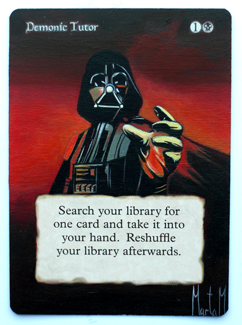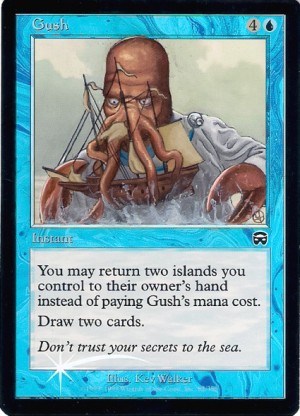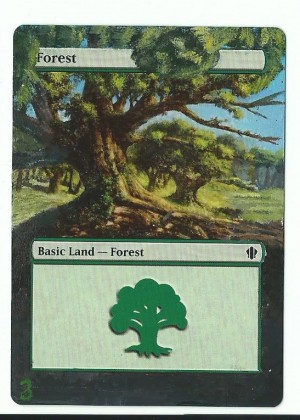Are you a Quiet Speculation member?
If not, now is a perfect time to join up! Our powerful tools, breaking-news analysis, and exclusive Discord channel will make sure you stay up to date and ahead of the curve.

The guy who painted the Eye of Sauron on the Sol Ring and has a Demonic Tutor with Darth Vader on it. His EDH general is borderless and, even though you act like you don't notice, you definitely do.
You may have thought about trying to alter a card yourself, but you are too afraid to ruin your cardboard. Those of you who are more financial minded have probably thought about how the alteration would impact the price of the card.
If you have thought about either of these things, be sure to keep reading.
Before we get into things, I think a quick introduction is in order.
My name is Mike. I’ve been playing Magic for over 9 years now. I'm a pretty decent player in my own right--someone who is certainly capable of owning FNMs here and there--but I'm otherwise unaccomplished.
My greatest accomplishment in Magic was when a fellow player saw a card I altered and liked it so much he paid me to make one for him. He then told his friends, and a couple of them also commissioned me for a couple of cards.
With the help of a little bit of an internet presence, this has become a part time income for me--one that has allowed me to pay for Magic using paint and time rather than cash.
What this column is...
These articles will be (almost) weekly. Every two weeks I will pick a card and alter it, then provide a guide with pictures on how I did so, including step by step instructions and some basic theory along the way.
On some off weeks I will have a more free form column, discussing topics ranging from how best to price and value your alters to tips on trading or selling them. I may even just review some excellent alters from around the internet for inspiration.
Along the way, I greatly welcome any feedback from readers. The more you talk to me, the better I can tailor these lessons to fit you.
What are the benefits?
Well, as I stated above, if you practice enough, you could become the "go to guy" for commission work in your area.
Another benefit is that you have yet another way to “pimp” your decks. Foil cards are generally the way players choose to do this, but imagine having all of your basic lands in exquisite full art. No one at your table, in your area, or even your local Grand Prix, will have a deck as unique as yours.

What does this have to do with finance?
This is the big question, isn't it? We all have those cards that are not quite bulk, yet not quite wanted, either.
I'm talking about those cards that are certainly EDH playable but aren't foil, or perhaps that fringe Legacy sideboard card you know you don't want to toss into your bulk box.
Simply extending the borders on a card like this not only increases its value, but also makes it a star in your binder. People always notice altered cards and almost always comment on them. This kind of attention isn't too shabby for what used to be a regular old Gush in your binder.
But I’m not an artist….
Whenever people see my cards, the first thing they say, after they ask “did you do that?’, is that they “don’t have the talent” to do something like that.
I believe that this is false. I have always maintained that if you can write with a pen, you can paint.
It does take a bit of practice, though, and, in some cases, a touch of direction. Which is where I come in.
That being said, I think now is a good time for you to start painting. I find that the best way to learn something is to just go for it. This will give you a good idea of your baseline skills and teach you a bit about the hobby before I go ahead with the instruction. Experimenting will lead to more learning than reading a guide will ever do.
Choose a bulk common to practice on. Something with a simple design, perhaps with a small range of color. Basic lands work perfectly for this.
Find yourself a clear surface to work on. Be sure to use newspaper on anything that is not going to be primarily a designated paint area.
Make sure also to have good light to work with. Use your white paint to create a thin primer layer.
While that’s drying, use the paint and your knowledge of the color wheel to try and match the colors on the card. Remember that it won't take very much paint to cover such a small area. If your paint is too thick, you can thin it with a bit of water.
The idea is to train your eye to see through the illusions created by the colors at work. Don’t be discouraged, this is the most difficult thing about altering any card, but it can be mastered with some practice.
Here's what you'll need:
Tools of the Trade:
There are a number of things that can be helpful when painting, but this list will only show you the most basic necessities. I don’t want to price you right out of the game before we start.
- Paint – I use Liquitex brand acrylic paint. This can be found in a starter set at your local craft store for around $20. The set will include Naphtol Crimson, Phthyalocyanine Green, Cadmium Yellow, Brilliant Blue Purple, Mars Black, and Titanium White. Please don't be intimidated by the names of these colors. And yes, they are ridiculous.
- Brushes – This is subject to preference, but for the purposes of this list, I like to use a flat blending brush, size number 4 or smaller. These can vary in price from $2-$12, and I haven’t noticed a difference in quality, so feel free to go cheap. It helps to have two or three different sizes, though.
- Canvas – You’ll notice that I mount my cards on a 4in x 6in canvas. These aren’t necessary, but you do want to find something to mount your cards on. Anything from cardboard to scrap wood will do. The goal is to be able to pick up your card without touching it.
- Tooth Picks – The most dangerous tool in your arsenal. The hope is that you’ll only use these to clean up edges, but, unfortunately, they will scrape away more than that if you are not careful. A hundred tooth picks might cost you a dollar.
- Paint Pallet - This gives you a place to actually mix the paints into more interesting and appropriate colors. You can find these next to the paints in your local craft store. A little round plastic one will cost you a dollar, but I use a glossy ceramic tile. It's easier to clean and can often be had for free as a sample from home improvement stores. Another free solution would be a dinner plate, as we are using water based acrylic paint. The paints should come right off.
- Small Cup – This is for water to rinse your brushes.
- Paper Towel – Always handy…
So go to town and enjoy! Tweet me your progress, questions and comments @PaintersServant.
See you next week.







I just wanted to say I think this is a brilliant idea for a series. I’m noticing an uptick in players wanting altered cards (we have a very good alterist in our area) and you can turn cards that buylist for 10 cents (and sell for 25) into $10+ with a bit of time and effort.
Thanks for reading, I appreciate the comment!
Indeed interesting series. I’m glad to see this.
A few questions:
– what is your experience in drawing and painting before you started doing alters? You say everyone can do alters, but I guess you have at least some experience with drawing before that.
I’m pretty sure I’m a complete newbie to this, and things like “flat blending brush, size number 4 or smaller” don’t mean anything to me. What is a flat blending brush anyway? Are there brushing not flat or not blending? (don’t need to answer ).
).
– the comment above me says that it would be great to make a craprare into a 10 dollar card.
I want to note that
A. You need to sell it first
B. you should spend less then 1 hour work on the alter, otherwise you earn less than 10 dollar/hour.
C. What about the time you spend on practice?
D. You also need to earn back the investment in material.
I can hardly believe it’s worth the time just for financial purpose. If you like drawing and painting, go for it!
But if it’s just for financial purpose, I have my doubts.
Anyway, if you always wanted to start doing this, this article hopefully convince you to give it a try! And hopefully, everyone shares his learning evolution!
I agree that you’d likely only want it to take an hour or so (to keep your hourly wage even remotely reasonable), but I know the alterist around here only charges per the type of alter…so whether you want it full-arted and it’s very intricate or much simpler same cost….so hourly his wage likely changes, but he enjoys it, and he does it to increase the value of his trade binder (he doesn’t have much cash to throw around picking up staples…so making an altered sol ring go from $2.5 to $10-15 is a good way to increase it’s value without spend a lot of money)
Here’s the advice I am able to provide you with. Granted it is only one source of experience and you may take it as you feel is necessary. To answer the brush questions, paint is a different material (“medium”) to work with. Unlike pencils, you cannot sketch lightly and darken as you go. You must have a general idea or plan, as overlapping colors will cause desired or undesired pigment changes. For this, you have different brush formats (Round, Flat, Bright, Filbert, Fan, Angle, Mop and Rigger)
I will classify these into:
1. Flat, Bright, Fan & Angle – These ones you are able to apply a moderate amount of paint, or brush paint across to blend it. (Making smooth color transition) The type of these brushes will grant you finer or more broad capability in application. A finer flat or low number fan will be the only ones you likely use.
2. Mop and Filbert – These 2 will be your slop houses. Similar to a Blush makeup brush they allow you a larger area of blending and application. **The amount of paint contained on the brush will effect how well you will blend** (i.e. less paint gives better control over wide area) You will likely never use these on cards.
3. Round and Rigger – These are going to be your smallest point tipped brushes. They will allow you to create fine lines and dot patterns in application. More paint on the tip will be better, as reapplying the same area is difficult and sloppy with these brushes at fine points. These will be a go-to brush with detail intensive alters.
*The higher the brush # is, the larger the bristle area will be.
#1 –> . and #5 –> o (Not actual, just relative)
=============================================================
Addressing your other concern, no experience is required to start. The best advise I can provide, is find a style you can comfortably practice, emulate or develop. (Comic Book style, Sketch, Line Art, Boats, Mythic Creatures, Shading, High Detail, Low Detail, etc.) Practice, practice, practice. You should have maybe a million lands sitting around–use these to get acquainted with how paint applies to the card. Painting on cards is difficult and becomes frustrating working in a tiny space and not seeing the results you want.
I recommend buying an illuminated magnifying glass that clamps on a table space and has a boom arm for control. You can find one for about $20. Believe me, your eyes will thank you for it.
Here is one that I did in February. It should be high enough resolution to see that it isn’t super smooth, but when you are playing with it or back up a little, looks flawless. It takes time and practice. One final tip, is acrylic dries rather fast, so you will need to adjust to that as well.
http://postimg.org/image/ix6gbzu57/
My first article and already I’m outclassed lol! Thanks for explaining all of that, I may reference this in future columns. That turtle shell alter is fun, and well done.
I wouldn’t say outclassed. The information you provided, I thought, is a great synopsis and segway into the world of altering–plus its secondary market. You definitely laid the foundation and sparked interest into the topic. I look forward to more of your articles, broadening my perspective and knowledge, through interaction spawned in discussion.
Thank you for the compliment on the Ponder. I’ve been practicing for about a year now and doing some commons and token alters. (I think tokens are a fantastic way to build and perfect a persons style) In the end, I am glad you are taking the plunge into narrating this ‘mysteriously secret’ skill. Free resources often keep out key information and are very reluctant to explain approach.
I’ve had a few art classes from high school and college. I assure you that most of it doesnt translate. The size of the area that you are painting is so small that most of the time just hinting at detail is enough.
As for time, a borderless alter can take me anywhere from 30-45 minutes. I’ll talk about what I think are proper prices policies (alliteration, hell yea!) in a future column, because it is very important as you pointed out.
I’ve completed some altered cards for players. The most common I’ve done work for is the EDH community. More appropriately, they will enjoy the uniqueness that the alter brings to their deck. I’ve never seen anyone take my work and go to a tournament with it. Be even harder pressed to find an artist with a warranty system ;p
My “warranty policy” if you want to call it that is as follows: If you dont like the results of any card under $25 in value, I’ll replace it. Over $25, buyer beware.
I let me own work speak for itself, and I’m confident that I can sell the alter that my customer passed on to get my money back. There are special cases where having personalized cards with names on them, obviously, but this gets me by and gives my customers a bit of confidence in me as well.
Good article. What I really appreciate here is the idea of adding value by learning a skill, not just by watching the pro tour and reading tea leaves about the value of Magic cards. When you’re done playing the Magic finance game, the skills you picked up in evaluating Magic cards won’t translate into other endeavors nearly as well as painting cards will translate into painting other things.
Also — and this is a touchy subject — the more people who can do impressive alters, the more people we have that can satisfy the demand for good-looking proxy cards for Cube and whatnot without feeding the counterfeit scammers. A win all around.
You are right, that IS a touchy subject
So much easier said than done, but I appreciate your optimism and faith in my horrid artistic abilities. I won’t lie, altering is always something I wanted to do, especially for my cube, but I’m one of those who doesn’t think they can do it. This is an interesting series idea and it’s especially ideal for financiers. Altering a 15 cent card, even in minor way can turn it into a desired $7-$10 card.
I do have faith in your “horrid” abilities. As you’ll see in future column, its not about artistic ability (though that helps) its more about being able to see and match colors.
You are right though, this is easier said than done. My hope is that someone like you might pick a lazy Sunday and try it, even if you ruin a couple of Islands.
Mike, this seems like an excellent opportunity to find a local and coach them and share your results – show that anyone can do this!
This sounds like a fun idea if I can find a willing participant. I’ll look into that.
indeed, exactly my thought. I hope you can proof us wrong :D.
Will you provide tips and tricks to see the colors like artists do?
Yes indeed! I’m actually planning a whole article about color theory